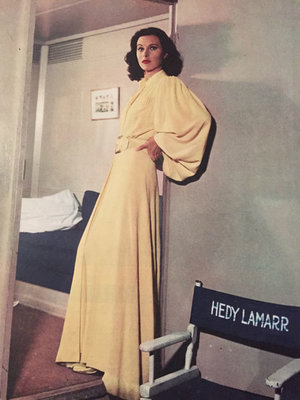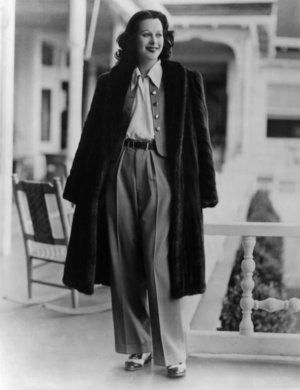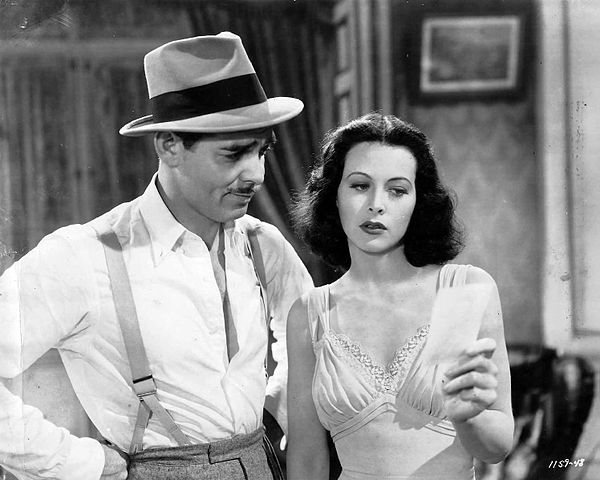
She was the essence of beauty and brains.
She was Hedy Lamarr, the alluring Hollywood actress and brilliant amateur scientist whose secret communication device ushered in the brave new era of cell phones, WiFi, drones, Bluetooth technology and GPS guidance systems.
One of the most glamorous movie stars of the late 1930s and early 1940s, she’s the subject of Alexandra Dean’s first-rate documentary, Bombshell: The Hedy Lamarr Story, which opens in Toronto at the Hot Docs Ted Rogers Cinema on November 24.
Born in 1914 as Hedwig Eva Maria Kiesler, she was the daughter of wealthy, assimilated, cultured Austrian Jews. Her father was a banker and her mother was a pianist. They lived charmed lives until Austria was upended by political chaos.
Lamarr had the good fortune to leave Vienna before Nazi Germany annexed Austria. By then, she had appeared in Ecstasy, a risqué film which caused a sensation in Europe. Lamarr’s appearance in Algiers (1938), her first Hollywood movie, catapulted her to stardom. But by the mid-1940s, her high-flying career had stalled.
Dean presents Lamarr as a complex, highly intelligent woman who was dogged by a mercurial personality. “I’m a simple, complicated person,” she told an American television talk show host in 1969.
Her son, Anthony, agrees with her self-appraisal, saying she had many “sides and faces.”

Lamarr lived during an epoch when women were judged almost solely by their looks. Indeed, she was widely recognized as one of the most beautiful actresses in Hollywood, her name lit up in bright lights. “Any girl can be glamorous,” she once quipped. “All you have to do is stand still and look stupid.” Few, however, were aware of her formidable intellectual side and her solid accomplishments as an inventor who was blessed with a curious, original mind.
Dean paints a rounded portrait of Lamarr through interviews with observers of the Hollywood scene, scientists and members of her family. She also relies on a substantive set of 1990 audio tape interviews with Lamarr that went missing and suddenly turned up.

She entered show business at the age of 16 with a cameo role in a now-forgotten German movie. In 1933, she won in role in Ecstasy, a Czech film that required her to appear naked in several scenes and simulate an orgasm. Critics condemned it. Her father, whom she adored, was upset as well.
Lamarr’s first of six husbands, Fritz Mandl, was an Austrian arms manufacturer 15 years her senior. Described as the Henry Ford of Austria, he was a Nazi sympathizer of partial Jewish descent. One of their house guests was none other than the leader of fascist Italy, Benito Mussolini.
Unhappy in her marriage due to his jealous and controlling temperament, she left Mandl in 1937 and settled in London. There she met the Hollywood studio mogul Louis B. Mayer, who offered her a job, despite her broken English. Apart from giving her a big break, Mayer is credited with renaming Lamarr. In Hollywood, Dean claims, she was a serial seducer of men and women alike. Among her apparent lovers was John Fitzgerald Kennedy, the future U.S. president, and Howard Hughes, the industrialist.

She hit her stride in the 1940 movie, Boom Town, starring the heartthrob Clark Gable. Yet she was such an insecure person that she denied she was Jewish.
Even as her career blossomed, she dabbled in science. Working with a colleague, she invented a radio-controlled torpedo based on the concept of “frequency hopping.” After testing it, the U.S. Navy rejected it. When her patent expired, the American government expropriated it to develop a nuclear command and control system.
As World War II raged, she sold $25 million worth of U.S. war bonds. She also starred in White Cargo, a third-rate potboiler in which she played a cheap sex object. Eventually, she acquired a reputation for being difficult on set. After the war, she became an independent producer, but her films were flops. In 1949, she appeared in Cecil B. DeMille’s Samson and Delilah, which revived her lagging career. But five years later, she lost all her savings in the production of the forgettable Loves of Three Queens.

The darkest period in Lamarr’s life occurred when her marriage to a Texas millionaire collapsed. Following a bitter divorce, she suffered a nervous breakdown. In the years ahead, Lamarr exhibited erratic and unstable behavior. “She was a woman of extremes,” says her son in a brutally honest assessment.
In 1966, she was caught shoplifting. Claiming it had all been a “misunderstanding,” she was acquitted. As she aged, she resorted to plastic surgery to a grotesque degree and retreated into herself to such an extent that she became something of a recluse.
Lamarr was one of the reigning queens of Hollywood during its golden heyday, but her final years were less than regal. This, of course, was the tragedy of Hedy Lamarr, as this revealing biopic suggests.
